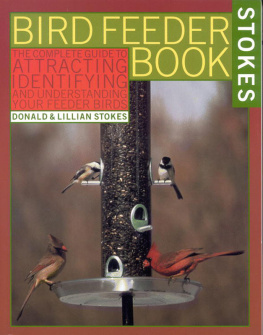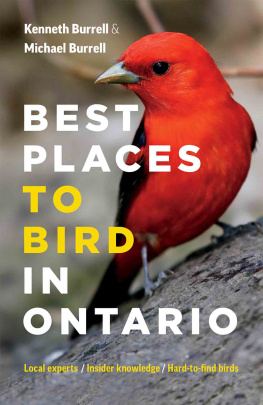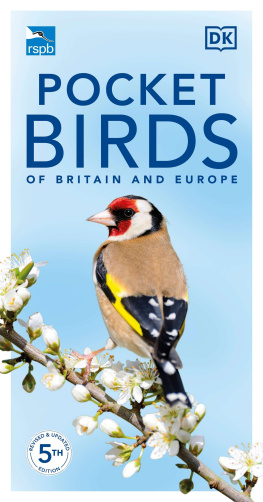Local experts
Insider knowledge
Hard-to-find birds

A Bairds Sparrow, one of our grassland specialists. In Canada, they are found only in Alberta, Saskatchewan, and Manitoba.
ILYA POVALYAEV

Copyright 2018 by John Acorn, Alan Smith, and Nicola Koper
Foreword copyright 2018 by Candace Savage
All rights reserved. No part of this book may be reproduced, stored in a retrieval system, or transmitted, in any form or by any means, without the prior written consent of the publisher or a licence from the Canadian Copyright Licensing Agency (Access Copyright). For a copyright licence, visit accesscopyright.ca or call toll free to 1-800-893-5777.
Greystone Books Ltd.
www.greystonebooks.com
Cataloguing data available from Library and Archives Canada
ISBN 978-1- 77164-326-9 (pbk.)
ISBN 978-1-77164-327-6 (epub)
Series editors: Russell Cannings and Richard Cannings
Editing by Lesley Cameron
Cover design by Nayeli Jimenez
Interior design by Naomi MacDougall
Cover photograph by Nick Saunders
Photographs by John Acorn, pp. 20, 25, 26, 38, 50, 62, 71; Barbara Bleho, p. 188;
Paulson Des Brisay, p. 166; Jennifer Horvat, p. 232; Ryan McDonald, p. 174;
Ilya Povalyaev, pp. xiv, 182, 194, 202, 210, 218, 224, 238, 246; Gerald Romanchuk,
pp. x, 8, 14, 32, 44, 56, 66, 72; Nick Saunders, pp. 80, 86, 92, 100, 114, 128, 141, 152, 158; and Alan R. Smith, pp. 5, 106, 120, 134, 144.
Maps by Eric Leinberger
We gratefully acknowledge the support of the Canada Council for the Arts, the British Columbia Arts Council, the Province of British Columbia through the Book Publishing Tax Credit, and the Government of Canada for our publishing activities.

CONTENTS


Rock Wrens do indeed prefer rocky places, such as canyons and badlands.
GERALD ROMANCHUK
FOREWORD
YOU HEARD IT here first: Canadas three midwestern provinces are a paradise for birdwatchers. Were talking about a region that spans 1.8 million square km (almost 700,000 square mi.), more than three times the size of France, and an immense territory that invites superlatives. To the north, broad swaths of boreal and mixed-wood forests receive an annual influx of migrating songbirds, millions upon millions of them, drawn to some of the richest and most productive breeding grounds anywhere in the world. Farther south, wide-open expanses of prairie provide living space for grassland specialists like Greater Sage-Grouse and Long-billed Curlews, permitting them to extend their range into northerly latitudes. Meanwhile, the regions thousands of prairie potholes, or wetlands, are home to enormous flocks of ducks that hatch out most of the ducklings on the continent. Add in rugged mountains, active sand dunes, even a strip of Arctic coast, and it becomes easy to understand why birdwatching in the so-called Prairie provinces can provide a lifetime of fascination and happiness.
And yet, it would be easy to miss out on all the fun if you didnt know where to look. As impressively varied as the region is, its also a country of broad strokes, long distances, and deceptive sameness, and it can pass us by in a blur, an endless dull streak on the far side of the car window. Thats why the book that you have in your hands is so welcome and valuable. In these pages, three seasoned birders, each an expert on his or her own home province, offer detailed introductions to their own personal birding hot spots. Some of their recommendations are almost mandatoryan array of national, provincial, and municipal parks, for example, or Manitobas famous Oak Hammock Marshbut others are wonderfully quirky. Who wouldnt want to hang out in a decaying industrial site with John Acorn, watching Gyrfalcons and Prairie Falcons strike at pigeons (mostly without success) or to head down an ever-dwindling trail with Alan Smith to look for Belted Kingfishers at the confluence of the South Saskatchewan and Red Deer Rivers? Who wouldnt want to help Nicola Koper check Assiniboine School in Winnipeg for nesting Chimney Swifts? Its exciting to be trusted with this kind of insider information.
Ive spent most of my life in the Prairie provinces, and though Im not a Very Serious Birderno life list or target species for meI usually have my binoculars and bird book within easy reach. I know a marsh from a meadow, a cowbird from a chickadee. And yet, thanks to the generosity of these authors, I am reminded how much I have yet to discover and how thrilling those discoveries can be. For instance, it says right here that Harlequin Ducks, which Ive never seen and which are spectacular, have sometimes been spotted on the river not far from my home. So now, if youll excuse me, Ill look forward to seeing you later, out on the birding trail.
CANDACE SAVAGE
Saskatoon, Saskatchewan
July 2017

Snowy egrets are a rare but welcome visitor to our Prairie provinces.
ILYA POVALYAEV
INTRODUCTION
A JOURNEY THROUGH THE PRAIRIE PROVINCES
MANY CANADIANS WHO havent travelled through Alberta, Saskatchewan, and Manitoba think of the Prairies as a monotonous monoculture of wheat, but the three Prairie provinces actually form a vast and diverse landscape. Travelling across the Prairie provinces offers an always-changing birdscape. There are broad, largely unseen boundaries between eastern and western species, the legacy of the recolonization of northern North America after the retreat of the Pleistocene ice sheets. The journey north takes you from hot desert grasslands through a wide variety of forests to the harsh tundras of the Arctic. And with a diversity in landforms from flat plains to some of the most spectacular mountains in the world comes a multitude of habitats that support some of the most diverse breeding bird faunas in North America.
Southeastern Manitoba marks the western extent of eastern hardwood forests, home to species such as Eastern Screech-Owl, Wood Thrush, and Scarlet Tanager. The moister grasslands of southern Manitoba, with species such as Bobolink, give way as you move west to the drier grasslands of southern Saskatchewan and southern Alberta, where Spragues Pipits and Chestnut-collared Longspurs sing above the plains. And in southwestern Saskatchewan and southeastern Alberta, the dry, shortgrass prairies are home to species such as McCowns Longspurs and Brewers Sparrows.
The boreal forest extends in a broad arc from central Manitoba west to northern Alberta. These forests are highly diverse on even a local scale, with a rich mixture of pine, spruce, birch, and aspen forests, thousands of lakes, marshes, and other wetlands, and a mosaic of grasslands along their southern border. Many species of warblers occupy different forest types, while Great Gray Owls hunt in forest openings and Yellow Rails call from wet sedge meadows.




















